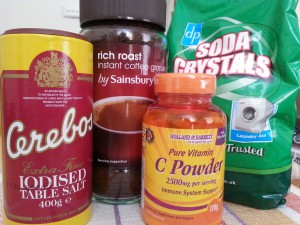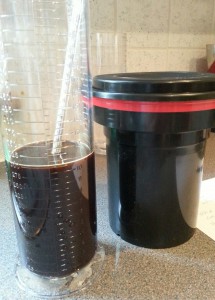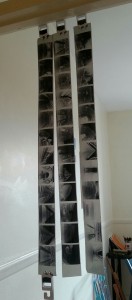Peak Imaging is my film processing lab of choice, since they have provided consistently good results and have very fast turn around times. Even if I can send the film off and get it back within 3 days though, that is still 3 days longer than it takes me to see digital photographs. A number of friends develop their own B&W film at home, since you don’t actually need a proper dark room – a small changing bag suffices to transfer the films into the light proof processing tank. I’ve thought about doing this before, but the idea of dealing with lots of chemicals was never too appealing. While researching B&W film processing recently, I happened across an article on a website (I forget which exactly) mentioning that it is possible to develop film using home-brewed developer based on little more than instant coffee. The moment I read about this, I knew I had to try it out for myself.
The science bit
After a little more reading, I’ve learnt that Caffenol developers have 3 key ingredients, each serving a specific purpose.
- Instant coffee. This contains a variety of chemicals including caffeine, but the one that is thought relevant to film development is caffeic acid. This is a phenol which acts as the first developing agent reducing the silver halide to metallic silver, revealing an image on the film base.
- Washing soda. Photographic developing agents require an alkaline solution to activate them, but coffee is fairly acidic. Washing soda, aka sodium carbonate, acts as the accelerator raising the PH to a suitable level for the developing agent to operate.
- Vitamin-C. Caffeic acid on its own will result in very long development times, so the Caffenol-C recipes add ascorbic acid (aka vitamin-C) as a second developing agent to further speed up the reactions.
Reinhold’s basic recipe for these 3 ingredients, Caffenol-C-M, is only suitable for use with film rated at 100 ISO (or lower). It is said to cause fogging of high ISO films during development. I primarily shoot Tri-X 400 in my ZeroImage 2000 pinhole camera, so the slightly more advanced, Caffenol-C-H recipe, was the one to go for – the ‘H’ stands for “High Speed”. This adds a fourth ingredient, Potassium Bromide, which acts as a restrainer to prevent fogging. The minor irritation is that the latter isn’t a common household ingredient. Fortunately Reinhold has since found that Iodized salt can be used in place of Potassium Bromide, and this is fairly easily found in supermarkets.
Getting started
I hadn’t done any film processing at home before, so the first step was to obtain the minimal set of equipment. The Patterson film processing kit is a cost effective way to obtain the core pieces, vs buying them all separately, though searching for second hand items on eBay could probably cut cost even more. In addition, I got the cheapest digital scales that Silverprint stocked and a concertina storage bottle for storing fixer between use.
The recipes linked above need a little tweaking based on the precise ingredients used. In particular washing soda comes in a variety of formulations, anhydrous, monohydrate & decahydrate. Most of the recipes published on the web assume use of the andhyrous (waterfree) formulation, but it is possible to figure out the amount by which to adjust the quantities, by heating in an oven and measuring the weightloss. In the UK the most easily available washing soda is Dri-Pak Soda Crystals, for which people have already verified an adjustment value of x2.7. There isn’t any available data on the amount of caffeic acid in the instant coffees you can get in supermarkets, but fortunately this doesn’t seem to matter much – people have got acceptable results with almost any instant coffee. So don’t waste money on the most expensive brands – pick any old cheap bottle of instant coffee. Pure Vitamin-C powder is available in most pharmacies in the UK, but at stupidly expensive prices. Holland & Barrett have tubs at slightly more reasonable prices, particularly when they have 2-for-1 special offers available. For the final ingredient, iodized salt, the only brand commonly available in UK is Cerebos Extra Fine Iodised Table Salt.
Caffenol-C-H-UK Recipe
With all that in mind, the following is a specific recipe derived from Reinhold’s Caffenol-C-H using ingredients available in the UK to make 1 litre of solution. I’m calling this Caffenol-C-H-UK.
- 150g Dri-Pak Soda Crystals. Cost: £1.00 for 1kg
- 16g Holland and Barrett Vitamin-C powder. Cost: £6.99 for 170g
- 40g Sainsbury’s Rich Roast Instant Coffee. Cost: £2.00 for 200g
- 12g Cerebos Iodized Table Salt. Cost: £0.75 for 400g
- water to make 1000ml of solution. Cost: free(-ish)
For a single 35mm film only 300ml of solution is required, so the quantities are
- 45g soda crystals. Cost: £0.045
- 4.8g vitamin C. Cost: £0.20
- 12g coffee. Cost: £0.12
- 3.6g salt. Cost: £0.006
- water to make 300ml of solution
- Cost: £0.37 per roll.
while for a single 120mm (medium format) roll film, 600ml of solution is required
- 90g soda crystals. Cost: £0.09
- 9.6g vitamin C. Cost: £0.40
- 24g coffee. Cost: £0.24
- 7.2g salt. Cost: £0.01
- water to make 600ml of solution
- Cost: £0.74 per roll
Compared to mail order film processing at about £4-5 per roll of film, or high street processing of as much as £10, Caffenol is very cheap. If you can get cheaper sources of Vitamin-C powder, then the cost will be drop even further. Of course this assumes your time is free too.
Mixing the developer
The critical thing to bear in mind when mixing up caffenol developer is that you are not making soup, rather you are attempting to perform a specific set of chemical reactions. For this reason, it is not advisable to simply mix all the ingredients in one go, instead follow a precise order of mixing.
- Fill the measuring cylinder with half the target volume of water from the cold tap. ie if the end goal is 600ml of solution, then fill with 300ml of water
- Pour in the soda crystals and stir for a couple of minutes until they are well dissolved. Since Dri-Pak soda crystals are a decahydrate, the temperature of the water will typically drop 8-10 degrees and the volume of solution will increase. NB anhydrous soda crystals would have instead raised the temperature.
- Pour in the vitamin C and stir, at the very least until it has stopped fizzing.
- Pour in the instant coffee granules and stir for about a minute. The solution will now be a disgusting looking brown sludge :-)
- Pour in the the Iodized salt and stir some more.
- Top up with further tap water to achieve the final desired volume of solution. The developer is intended to work at 20 C, and mixing in the soda crystals will have lowered it to about 10 C. So when topping up to the final volume, add hot water at first until it is 20 C, then finish topping up with cold tap water.
After everything is thoroughly mixed, allow the developer to stand for 5 minutes to ensure all the desired chemical reactions have completed. If you could not get the temperature to exactly 20 C during the mixing phase, then sit the cylinder in a basin of hot or chilled water as necessary to adjust to 20 C, stirring all the time.
Processing the film
From this point onwards, fairly standard dark room film processing rules apply. Pour the Caffenol into the film tank, turn the stirrer several times and then seal the lid. Invert the tank 3 times and then bang it on the work surface to dislodge any bubbles. The quoted development time from Reinhold’s site is 15 minutes, but for the images produced with my pinhole camera on Tri-X I find 13 minutes gives a better result. I suggest going for 15 minutes at first, and if the result is too high contrast (indicating over development) try reducing it a couple of minutes next time around. During the development time, invert the tank 3 times at the start of each minute.
Caffenol does not require a chemical stop liquid, so when the development time is up, invert the film tank pouring the caffenol down the sink, then rinse multiple times with cold tap water. Keep rinsing until the water is no longer brown, as this minimizes subsequent staining of the fix. Once rinsed, add any regular fix and follow the normal process for that. Since my kitchen has no air extractor fan, I use Fotospeed odourless fix to minimize the fumes. Despite multiple rinses, the fixer will probably still end up stained light brown, but this does not appear to affect its ability to work in any way, so don’t discard it.
Once fixed, a thorough wash is needed. For this fill the tank with water, replace the lid and invert 5 times. Replace the water and then invert it 10 times. Replace the water once more and invert it 20 times. All that remains is to take 600ml of water, add a drop of Kodak PhotoFlo and dip the film squeegee into it. Then pour the water into the film tank, turn with the stirrer stick and invert it once to ensure the film is well coated. Now take the film off the reel, squeegee the water off it and hang it up to dry.
For some example images processing with Caffenol, browse images on my new portfolio website


